by Lucy Komisar
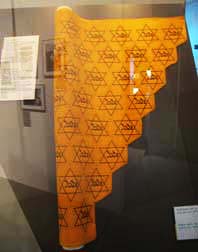
It was just a swatch of cloth, a fabric of golden yellow with eight rows of stars stamped in their outlines and waiting to be cut out. The stars were manufactured by the Berlin flag maker, Geitel & Co, and Jews had to pay 10 pfennig to buy them. Jews six and older had to wear them on their clothing.
From the horrifically mundane, to the surreally horrible, the Jewish Museum in Berlin, which opened in 2001, has an astonishing collection of exhibits. I thought I could do my routine two-hour walk-through, but I was so absorbed that I returned a second and third time. It is an extraordinary museum that uses photos, exhibits and audio to tell a fascinating and dramatic history of centuries.
The entrance is through the Collegienhaus, a baroque structure built in 1735 for the regal Court of Justice and rebuilt after its destruction in World War II. But most of the exhibits are in a postmodern building, a huge angular winding gray zinc structure that is said to have been inspired by a broken Star of David. It was designed by the American architect Daniel Libeskind and was completed in 1999. Inside now are exhibits that show two millennia of German Jewish history.
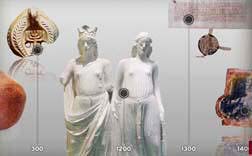
It starts start in medieval times with a replica of a 4th-century terra cotta oil lamp. There are copies of the 1235 sculptures Ecclesia and Synagoga, Church and Synagogue, representing the triumph of Christianity over Judaism. Ecclesia wears a crown and Synagoga is blindfolded, common on European churches. And a facsimile of a parchment and ink paper outlining residence restrictions for Jews in 1354.
The exhibits go to the present. They tell the story of Europe’s Jews who were prominent in German society – through the Middle Ages, the 18th-century Enlightenment with figures such as Moses Mendelssohn, the impact of political ideas of the 19th century, Jews in the Weimar Republic, and the repression that culminated in the Holocaust.

Everyone has their favorites in a museum. Here are mine. They focus on Jewish political and artistic achievements before the Nazis’ destruction. Here are some examples.
Walter Rathenau had been Germany’s foreign minister for four months, working for a new democratic state after World War I, when on June 24, 1922 he was murdered by members of an extreme rightwing secret organization. The nationalists and right-wingers, attacking him as representing the Jews Republic, made him a scapegoat for the conditions of the peace treaty which Germans considered harsh.
Here are three favorite oil paintings. Notice how they are all avant garde for the time and all use earth colors.

Joseph Budko (1888-1940), born in Poland but a student of art in Germany, painted Mother and Daughter in 1925. It deals with a topic being talked about then a lot: origins vs. future. In 1933, he settled in Palestine and in 1935 became the director of the New Bezalel School of Arts and Crafts. He did etchings and woodcuts and helped define and develop Israeli art.
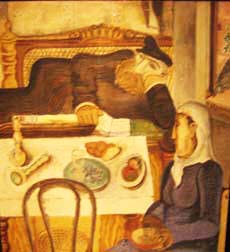
Jankel Adler’s Sabbath was painted in Düsseldorf 1927-28. It shows the end of the Sabbath, a man lying on his tallit and no longer reading from prayer book. His wife looks at the Sabbath table with its half eaten challah, an empty wine glass, and extinguished candles. Adler (1895-1949), was an avant garde artist who lived most of his life in Poland. Many of his paintings were confiscated by the Nazis. Sabbath was brought to Palestine in 1933 and returned to Germany in 1955.
Felix Nussabaum, who did this Self portrait, was a surrealist. He spent the last ten years of his life in exile, mostly in Belgium. When the Nazis attacked in 1940, Belgian police arrested him as a hostile alien and sent him to a French prison camp. He asked to be returned to Germany, and on the train escaped to Brussels.

He spent the next four years in hiding with Felka, the painter he would marry, with money from friends that allowed them to live and paint. The couple was captured by the Germans in 1944, a few months after his parents were murdered in Auschwitz. They were taken there as well; Felix, a major painter, died at 39.
Then I came to the room that shows an astonishing 1966 documentary made by a Canadian TV crew about the 1963 trial in Frankfurt of 22 members of the Auschwitz concentration camp administration and guards. I watched it several times. It was 18 years after the war.
The investigations and hearings of more than 1300 witnesses had gone on for four years. The trial of 183 days presented the facts of Nazi crimes to Germany and the international public.
The documentary makers were able to openly film the defendants entering the court house. They showed trial judges visiting Auschwitz to gather evidence, they showed Dr. Klehr (covering his face), who punctured a heart with a nail, and other arriving villains. They used a hidden camera to film briefly inside the courtroom.

In, 1965 six defendants were given life sentences, but eleven got only 3 ½ to 14 years in prison, and two were acquitted. There was a lot of debate about the leniency of most of the sentences.
The remembrance section of the museum is in the austere basement where corridors with particular themes cross each other. Some of them lead to high stone empty spaces called memory voids that represent what is missing from the death of 6 million European Jews. Only a tiny light comes though a slight opening near the top, as if the sides for some reason don‘t quite meet, providing a sense of disconnection, of disorientation.
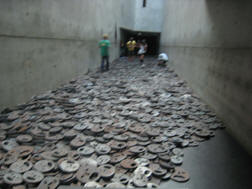
Menasche Kadishman’s installation Shalekhel (Fallen Leaves) 1997-2001, in one of the memory voids, is composed of more than 10,000 metal faces made from heavy round iron plates that cover the floor. The twisted mouths seem to scream, and visitors are encouraged to walk over them to hear the furious noise they make. Kadishman, lives in Tel Aviv, where he was born in 1932.

A passageway from the corridors leads to a ‘garden of exile’ of high stone slabs, perhaps tombstones, with a sloping stone floor that makes you lose your sense of stability. The goal is to make the visitor have not only an intellectual experience, but a physical one.

Holocaust Memorial
A couple of subway stops north and west to the Brandenburg Gate is a grimmer museum, the Memorial to the Murdered Jews of Europe. Built by the German parliament, it opened in May 2005.
It employs the same theme of funereal gray concrete slabs. Called stelae, there are 2011 in many sizes, from tall ones that create narrow corridor to flat slabs that seem like tombs. The architect was American Peter Eisenman. They connect underground to exhibits of particular families that were murdered, as if they were grave stones above bodies that are interred.

I got a sense of the massive geographical scope of the killing from a map that dotted the sites of persecution and extermination. They include sites of mass executions, extermination and concentration camps, ghettos, deportation routes and death marches.

But I also got the feeling of how personal the numbers were from an ordinary street photo of the Haberman family, the little girl in mary janes, the boy with a sailor hat and short pants. And from a collage of photos of victims representing various ages and genders.
There are rooms devoted to a Room of Dimensions with Fifteen personal accounts written down by Jewish men and women during the persecution; a Room of Families with the stories of fifteen Jewish families of different social, national and religious milieus; a Room of Names where the names and short biographies of Jews across Europe who were murdered or presumed dead are read out, something that takes six years, seven months and 27 days to complete.
There is a Room of Sites indicating using historical film and photos 220 of the sites where European Jews were persecuted and exterminated. There are also pages of testimony from Yad Vashem in Israel, and a Holocaust memorials database, which includes computer terminals providing information on current events at historical sites and on research institutions throughout Europe.
If you go
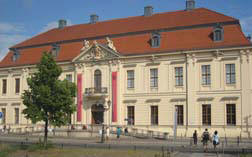
Jewish Museum Berlin
Lindensträe 9-14, 10969 Berlin
Info: +49 (0)30 259 93 300
Fax: +49 (0)30 259 93 409
U-Bahn Hallesches Tor or Kochstrasse.
info@jmberlin.de
Tours: fuehrungen@jmberlin.de
Monday 10 am to 10 pm; Tuesday-Sunday 10 am to 8 pm.
Admittance until 7 pm Tuesday-Sunday, 9 pm on Monday.
Entrance 5 Euros; 2.50 Euros for students, apprentices, welfare-recipients; children under six free; family ticket (2 adults and up to 4 children): 10 euros.
Audio guide: 2 euros (plus ID as deposit). The audio guide may take about 4 hours. There’s an introductory film.

Memorial to the Murdered Jews of Europe
Cora-Berliner-Sträe 1, 10117 Berlin
Phone 49 (0)30 26 39 43 36 (Mon – Thu 10.00 am – 4.00 pm, Fri 10.00 am – 1.00 pm);
Fax: 49 (0)30 26 39 43 21
U-Bahn Potsdamer Platz or Mohrenstrasse.
Admission free
Field of Stelae – 24 hours a day; Information Centre (museum) –
Apr. – Sep.: Tue – Sun 10 am – 8 pm (last admission: 7:15 pm)
Oct. – Mar.: Tue – Sun 10 am – 7 pm (last admission: 6:15 pm)
Closed on 1 Jan., 24 to 26 Dec. and 31 Dec;
If you don’t want to wait in line, which could take an hour or more in season, make a reservation in advance: besucherservice@stiftung-denkmal.de.n
Tours
A visit takes about an hour with an audio guide. The audio tour costs 3 Euros (1.50 Euros reduced). The exhibits also have audio and video broadcasts.
Guided Public Tours in English Sundays at 4 pm for up to 25 people. Meet at the elevator building at the corner of Cora-Berliner- and Hannah-Arendt-Sträe; cost 3 Euros (1.50 Euros reduced).

